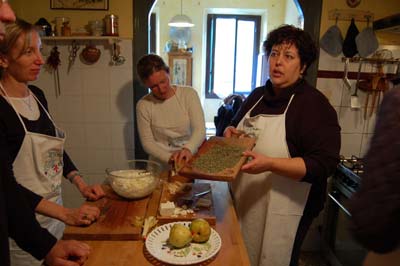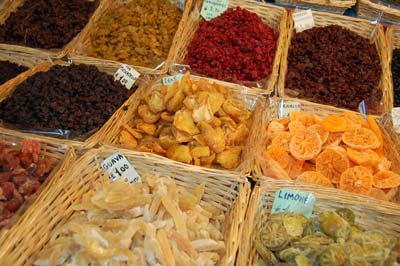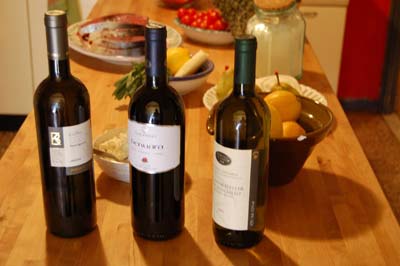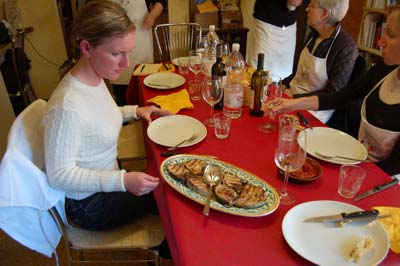Learning to cook like an Italian in Florence
Story by Dana McMahan, Photos by Dana & Brian McMahan and Holly Maynard.
I traveled to Italy with my husband, Brian, and another couple in March ’06, staying at a rented villa in Tuscany for a week. A highlight of the trip was a market tour and a hands-on cooking class in Florence at Divina Cucina (Via Taddea, 31, 50123 Florence, Italy; www.divinacucina.com), where I had won a class for two (valued at $375 per person) through a trip-report writing contest.
Change of plans
On the morning of the class we awoke to a dazzlingly sunny day. I had purchased train tickets from Trenitalia.com (€8.80 per person), and it was a 10- to 15-minute drive to the station in Rignano Sull’Arno. To be safe, we left 30 minutes early.
The drive was easy and enthralled us with an unfolding panorama of olive groves gilding the hills. The view of the tiny and very full parking lot was not so nice, however. We saw one space — a parallel one — obviously meant for a tiny Fiat Panda, not a mid-sized Nissan toting four Americans.
We drove aimlessly around the village and finally stopped so I could roll down my window and ask a police officer where we could park.
He responded in a flood of Italian, of course incomprehensible to me, and gestured down the street. We took this as an invitation to look further, but when the train’s time came and went with no space found, we decided to just drive into Florence.
A warm welcome
We made it without incident (other than making a few wrong turns) and parked within walking distance of the Divina Cucina cooking studio. We were greeted by Judy Witts Francini (“Diva”) calling out from the end of the street where she was waiting outside for us.
She immediately enveloped us in her enthusiastic and expansive personality as she told us about our fellow classmates: an Australian winemaker, a housewife from New York sent by her husband to learn to cook for him, and Sting’s chef (!).
Judy generously invited our friends to accompany us on the market tour portion of the class. Our classmates arrived and we set off down the narrow cobblestone street on foot for the nearby Central Market, San Lorenzo.
Our first stop was for fortification — cappuccinos at a bar inside the market. Judy explained that they turned on the espresso makers at 4:00 each morning and ran them nonstop for the best-tasting coffee.
Tasty shopping
The market tour was a feast for all senses. Judy’s ebullient manner made it even more fun. We paused to meet her various suppliers, including her adorable artichoke man, and exclaimed over the beautiful fruits and vegetables.
I had never understood the fuss about balsamic vinegar or why it was so expensive. That was before I tasted 50-year-old balsamico and was converted. We started with 12-year-old, which was lovely. The tasting samples got tinier as the age — and the price — went up. The last one was so thick, it barely trickled out of the bottle and had a gritty, sumptuous texture.
We also tasted some beautiful pecorino sheep’s cheese from a family farm with only 200 sheep. We started with a soft and creamy fresh cheese and worked through varying levels of aged cheeses.
Judy bought all of the ingredients for our meal: pears and pecorino for the homemade ravioli; artichokes, cherry tomatoes and blood oranges for the contorno (side dish), and incredibly fresh yellow fin tuna steaks, hacked right off the fish, with lemon and oregano for the sauce, plus gorgeous strawberries for the dessert.
Carrying our booty from the market, we crowded into Casa del Vino to have our wine selected. We shared wonderful little sandwiches of marinated cherry tomatoes, split and filled with capers, cheese and anchovies. A glass of prosecco each and we were in good form.
The last stop was for bread. Now laden with everything we needed for some serious cooking, we tramped to Judy’s apartment and got to work.
The lesson begins
First we prepared dessert in order to let it chill. We made panna cotta by dissolving fish gelatin sheets in water, adding it to the heavy cream cooking on the stove. The mixture went into little glass dishes to set while we prepared everything else. Judy explained that in the more powerful American refrigerators, we wouldn’t need nearly as much time for the dish to set.
We sliced strawberries and added a little sugar. The sugar would draw the moisture out of the berries and combine to make a sauce.
Next we started the artichoke dish by learning how to peel and chop artichokes. As we chopped them, they got a bath in vinegar water to prevent browning. We sliced garlic, which went into a cold pan of olive oil (putting it in hot oil burns the garlic, Judy taught us), then the artichokes went into the garlicky oil along with halved cherry tomatoes, some freshly squeezed blood orange juice and water to cover. This burbled along, providing tantalizing aromas while we continued with our other preparations.
Judy demonstrated the difference between lighter, low-gluten flour, good for pasta that’s served as a first course, and heavier semola (semolina) flour, suitable when you want a heartier, filling pasta. With nothing but an egg and the flour, Brian made pasta dough, and Judy taught us to use the pasta-rolling machine. I grated pecorino and we made the filling for the ravioli: tiny pear slices, pecorino and ricotta.
Once the pasta sheets were rolled out, we learned how to make various shapes and filled them all with the creamy pear filling. They were dropped into a large pot of boiling water, and Judy made the simple and delightful sauce — melted butter, lemon zest and fresh mint. It was time to eat!
Food, wine and new friends
We sat down in the sun-drenched dining room with glasses of white wine and enjoyed the fruits of our labor. The ravioli was divine. We had just enough to whet our appetites for the main course, tuna steaks, seared just a few minutes on each side and left vividly red and cool in the center then bathed in olive oil, oregano and lemon juice with a little leftover blood orange juice thrown in for good measure.
The conversation was fun and naturally revolved a lot around food. I had seconds of the tuna, a tactical mistake as dessert was still to come. Judy recommended I stand up for a few minutes and take some deep breaths to help prepare myself for the final course.
The panna cotta had set perfectly. Judy spooned the lovely strawberries on top and brought out the 30-year-old balsamic vinegar.
“Let me pour it for you,” she told Brian, “because I know you won’t pour enough.”
She generously streamed the thick, rich sauce over the strawberries, and I followed suit.
Facing this gorgeous bowl of creamy panna cotta, I longed for a more expandable stomach. I put forth my best effort and managed to finish all the berries and scrape every last little bit of precious balsamic off the panna cotta, but I just couldn’t finish the entire dessert. I had been skeptical when Judy told us we wouldn’t need dinner, but now I didn’t think I’d be able to eat for days.
The class was drawing to an end. It had been one of those rare and wonderful travel experiences that transports you completely into the task at hand, with no thought given to the rest of the day’s itinerary or where the next meal will be or what time you have to get up in the morning in order to squeeze in all the sights. It was totally engaging, in-the-moment fun.
Unfortunately, it was so fun that we were quite late meeting our friends at the Duomo to climb the dome and had to rush off to find them.
Judy stressed that her classes are about learning not recipes but techniques. She’s quite right, of course, and with our new repertoire I anticipate better-than-ever meals at our house — especially after stocking our kitchen with a pasta roller, a juicer and a ridged skillet perfect for searing our own tuna. Too bad there’s not a Duomo anywhere near our home that I can climb to allow me to eat like that every day!
You can follow our travels on my blog The Traveling McMahans.





